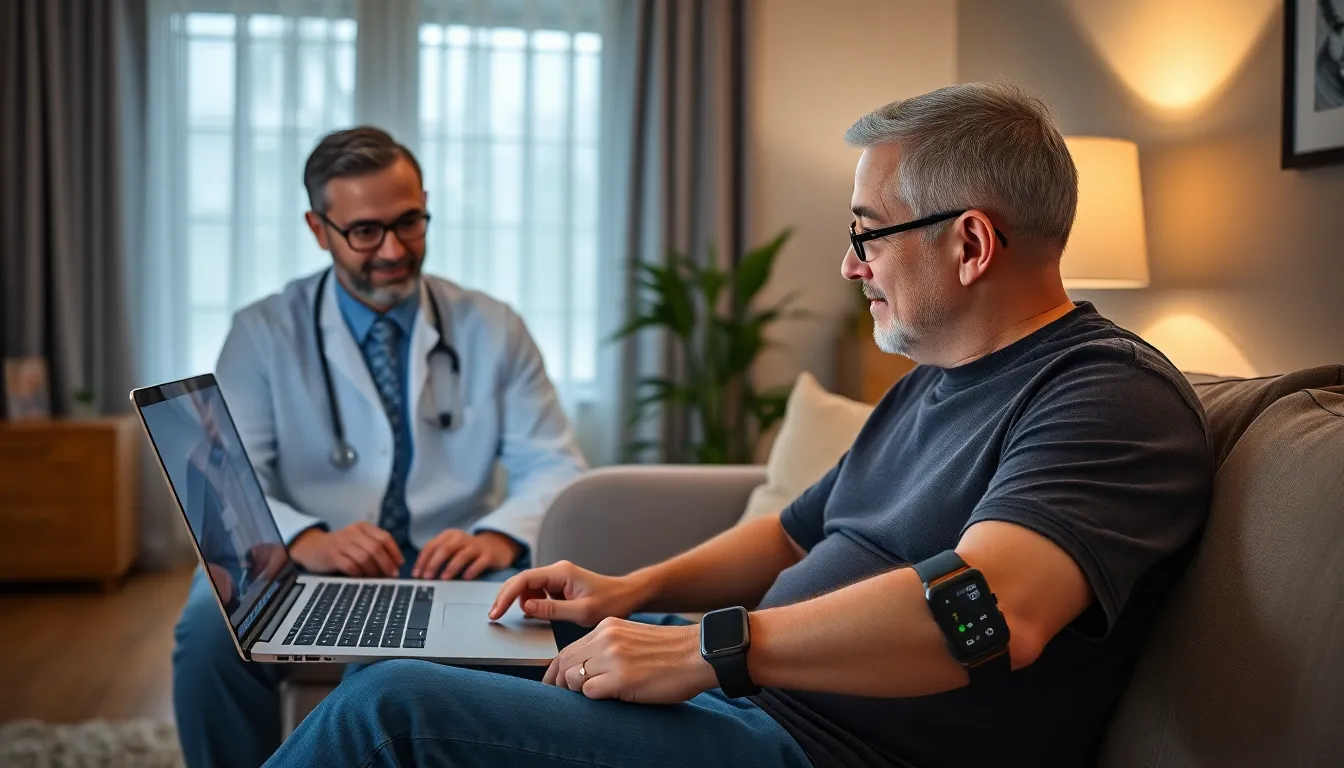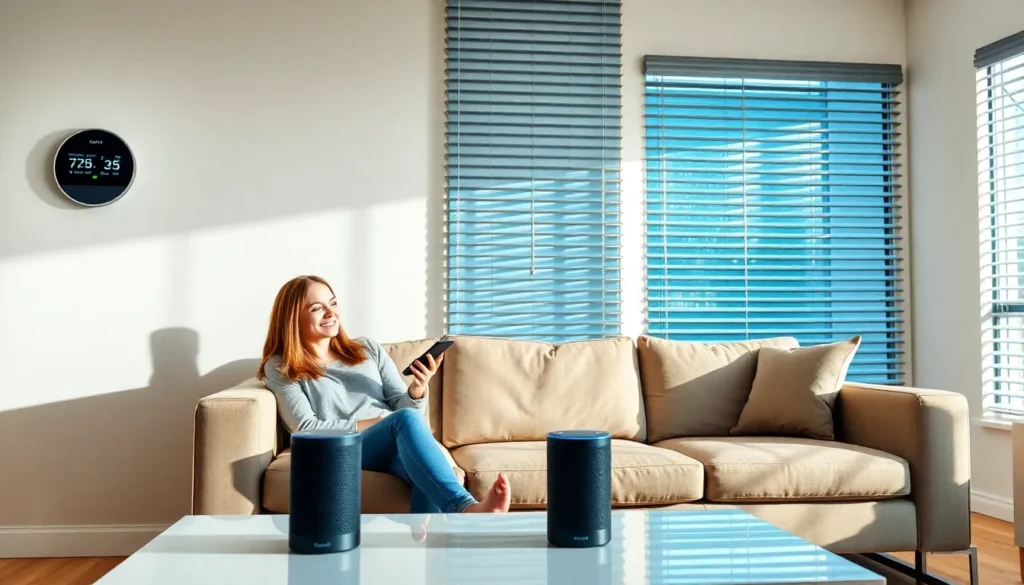Table of Contents
ToggleIn a world where wellness is the new black, home health trends are strutting down the runway like they own the place. From smart gadgets that track every heartbeat to meal kits that promise to turn even the most kitchen-challenged into gourmet chefs, the home health revolution is here, and it’s shaking things up.
Overview of Home Health Trends
Home health trends reflect a shift towards individual wellness and technological integration. Smart gadgets continuously gain traction in homes, allowing users to monitor vital health metrics like heart rate and glucose levels. Devices range from wearable fitness trackers to advanced blood pressure monitors, catering to diverse health needs.
Meal kits also reshape the culinary landscape for health-conscious individuals. These services simplify meal preparation, enabling inexperienced cooks to create nutritious gourmet dishes. Ingredients come pre-measured, reducing food waste and ensuring balanced meals.
Telehealth continues to expand, improving access to healthcare services. Virtual consultations enable patients to connect with healthcare providers from the comfort of their homes. This trend particularly benefits individuals in rural areas, where access to specialists might be limited.
Holistic wellness focuses on mental health alongside physical health. Mindfulness apps and guided meditation offer individuals tools to enhance their mental well-being. Various programs emphasize stress reduction and the importance of mental resilience.
Home rehabilitation technologies emerge as another significant trend. These systems assist individuals recovering from surgery or injury through guided exercises and monitoring. Progress tracking encourages adherence to rehabilitation plans.
Customized health plans also gain popularity, as individuals seek personalized approaches to wellness. Genetic testing and health assessments help create tailored diet and exercise plans. This personalized attention fosters better health outcomes and motivates adherence.
Overall, the integration of technology, personalized wellness solutions, and holistic approaches highlights the transformative nature of home health trends. These innovations significantly enhance everyday life through improved health management and lifestyle choices.
Emerging Technologies in Home Health

Emerging technologies significantly reshape home health, enhancing wellness and improving care accessibility. Innovations in telehealth and wearables highlight this transformation.
Telehealth Innovations
Telehealth platforms streamline healthcare delivery, enabling virtual consultations from home. Recent advancements include enhanced video quality and user-friendly interfaces, which increase patient engagement. Popular tools such as remote monitoring devices facilitate real-time health data tracking, making it easier for healthcare providers to respond quickly. Integration of AI chatbots also improves communication, offering instant support for routine queries. Patients from rural areas especially benefit, gaining access to specialized care without long travel times.
Wearable Health Devices
Wearable health devices empower individuals to actively manage their health. These gadgets, such as fitness trackers and smartwatches, monitor vital metrics like heart rate, sleep patterns, and activity levels. Enhanced accuracy and functionality in these devices support better lifestyle choices. Some wearables even allow users to connect directly with healthcare professionals, fostering a proactive approach to health management. Recent models also include features that track stress levels and provide real-time feedback, promoting mental wellness in addition to physical health.
Patient-Centered Care Models
Patient-centered care models prioritize individual needs, preferences, and values. These models emphasize collaboration between patients, families, and healthcare providers.
Personalized Care Plans
Personalized care plans focus on tailoring healthcare strategies to meet unique patient requirements. Utilizing genetic testing and comprehensive health assessments enables practitioners to develop customized approaches. Individual treatments may include specific medications, rehabilitation exercises, and nutritional guidance, designed to optimize recovery and enhance overall health. Continuous monitoring adjusts these plans as patient conditions evolve, ensuring solutions remain relevant and effective. Personalization fosters a sense of ownership, motivating patients to engage in their health journey actively.
Family Involvement in Care
Family involvement plays a crucial role in the success of patient-centered care. Including family members in decision-making encourages communication and support, making healthcare experience more effective. Family members often provide valuable insights into daily routines, preferences, and medical history, enriching the care process. They can assist with medication management, help establish health goals, and provide emotional encouragement during recovery. Collaborative care extends beyond the individual, creating a network of support that enhances health outcomes and aids in achieving optimal well-being.
The Role of Home Health Aides
Home health aides play a crucial role in the evolving landscape of home health. These professionals assist individuals with daily activities, ensuring comfort and independence. Responsibilities often include personal care, medication reminders, and support with mobility.
Aides foster meaningful connections with patients, which can enhance emotional well-being. Their presence often alleviates feelings of isolation, particularly among seniors. Furthermore, they serve as essential links between patients and healthcare providers, facilitating communication about any changes in health status.
Training for home health aides emphasizes technical skills and empathetic communication. Many complete programs that teach care techniques specific to various health conditions. These aides adapt to individual patient needs, utilizing personalized care plans showcased in current health trends.
In recent years, technology integration has influenced the work of home health aides. Many aides use mobile applications to track patient progress or communicate with family members. This integration allows for real-time updates and enhances collaborative care strategies.
The demand for home health aides continues to grow, driven by an aging population. The increased emphasis on in-home care reflects a shift toward patient-centered approaches. This trend aligns with the broader focus on wellness and individualized care expressed throughout the home health landscape.
Adequate support for home health aides ensures they can perform their vital duties effectively. Enhanced education and resources empower them to address complex patient needs. As home health trends progress, the role of these aides becomes more pivotal in shaping patient experiences and outcomes.
Challenges in Home Health Care
Costs associated with home health care continue to rise, creating significant barriers for many families. Unaffordable care often forces individuals to make difficult choices regarding their health needs. Accessibility remains a prevalent issue, especially in rural communities that lack adequate healthcare services.
Limited technological literacy can hinder patients and caregivers from effectively using telehealth platforms and monitoring devices. Awareness and education about available services are critical, as many individuals may not know what options exist for home health care. Insurance coverage discrepancies further complicate the situation, leading to inconsistent access to necessary support.
Quality of care presents an ongoing challenge, exacerbated by workforce shortages among home health aides. High turnover rates among these professionals can impact the consistency of care, affecting patient relationships and experiences. Additionally, training programs need to evolve to address the complex and diverse needs of patients, ensuring aides possess both technical and soft skills.
Communication barriers, including language and cultural differences, often lead to misunderstandings between patients and providers. This can result in suboptimal care and decreased patient satisfaction. Incorporating family members in care discussions can improve interactions, yet not all families are included in the decision-making process.
Coordination of care is essential for positive patient outcomes, though fragmented services can create confusion. A lack of comprehensive care plans may lead to missed appointments and inefficiencies in treatment. Integrating services through advanced health technologies offers a potential solution, promoting seamless communication among all parties involved.
In essence, recognizing and addressing these challenges is crucial for advancing home health care. Each obstacle presents an opportunity for improvement within the sector. Prioritizing solutions will enhance the overall effectiveness of home health services and positively impact patient quality of life.
Future of Home Health Trends
Innovations in home health continue to evolve, fueling significant advancements in how individuals manage their wellness. The ongoing integration of smart technology enhances the user experience, delivering real-time health metrics directly to consumers. Telehealth platforms are set to expand further, transforming virtual consultations into seamless experiences that prioritize patient engagement.
Wearable health devices play a major role in this transformation, offering features that monitor stress levels and promote mental well-being. These systems empower users, connecting them with healthcare professionals and fostering proactive health management. Continuous advancements suggest an increasing reliance on personalized data, with genetic testing paving the way for tailored health plans that address individual needs.
Patient-centered care models emphasize the importance of collaborations between patients, families, and healthcare providers. Individual preferences and values shape customized care strategies, which adapt to changing health conditions over time. The involvement of family members in decision-making processes strengthens communication and support, enhancing patient satisfaction.
The demand for home health aides appears on the rise, driven by the growing aging population. These aides provide essential support, ensuring patient comfort while enabling emotional connections. Training programs for home health aides are evolving, with a focus on both technical abilities and compassionate communication skills.
Access challenges remain relevant, particularly in rural areas, where technology literacy can affect the adoption of home health innovations. Addressing insurance coverage disparities is crucial for improving service accessibility. Efforts to offer coordinated care can reduce confusion among patients and families, promoting better health outcomes.
Overall, home health trends indicate a robust future focused on enhanced personal wellness, leveraging technology and personalized care to improve quality of life.
The landscape of home health is rapidly evolving with innovative technologies and personalized care solutions. As individuals increasingly prioritize their wellness, the integration of smart devices and telehealth services is transforming how healthcare is delivered. The focus on patient-centered models ensures that care is tailored to individual needs while fostering collaboration among patients, families, and healthcare providers.
Despite challenges such as accessibility and workforce shortages, the future of home health holds promise. Continued advancements in technology and a commitment to holistic wellness will likely enhance the quality of care. By addressing these obstacles, the home health sector can create a supportive environment that empowers individuals to take charge of their health and well-being.







